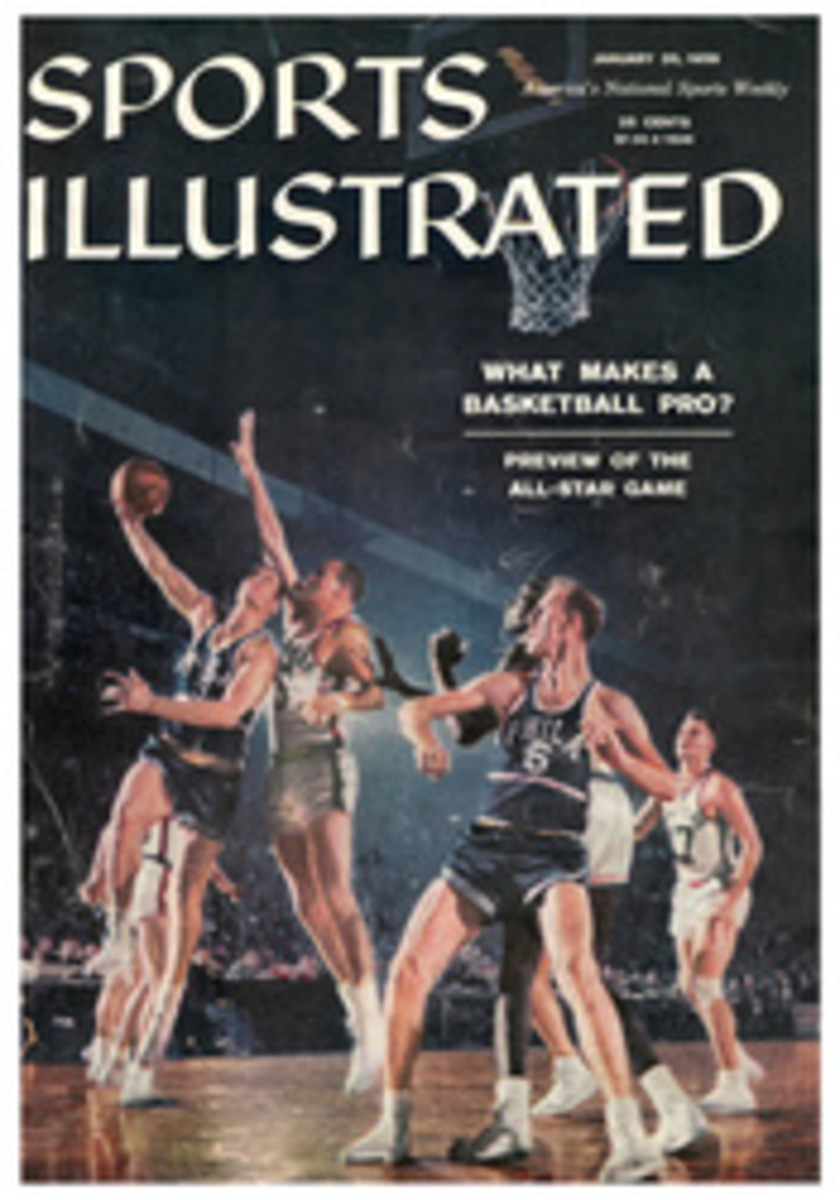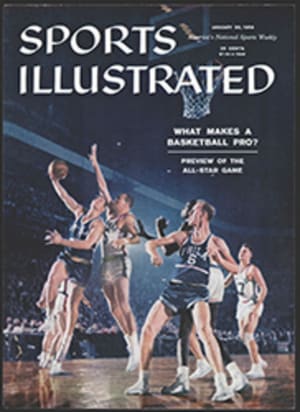
I Got the Horse Right Here
This week Hialeah Park starts its 40-day, stake-flecked meeting, during which almost a million people will bet close to $100 million on the past performances of race horses.
People will clip newspaper selections and take them to the track with them; comb the racing papers for help in selecting a winner, buy tout cards at the entrances to the track. But every public handicapper who tries to pick nine winners a day will end up losing, despite the inside information he claims to have. Possibly only one man, a 56-year-old iconoclast among horse selectors, will show a profit at the end of Hialeah and at the end of 1958 as well.
Through cartoon and code, inside information, chemistry, luck, deep-seated knowledge and a dash of voodoo, Kenneth Lionel Kling will try to beat the horses publicly in a syndicated cartoon named Joe and Asbestos. Until 1957 Kling had beaten the horses for 31 straight years. At the end of last year he was discouraged and outraged at having lost $161.50. By the time 1958 was 10 days old he had picked 8 winners out of 24 selections, including the third-highest-priced ($94.30) horse in his career. His tips are printed in code underneath his cartoon strip.
By watching every race every day except Saturdays, Kling is able to see things that most horseplayers never see. "A selector cannot do a competent job if he doesn't observe every race daily. Many things occur during a race which do not appear in the racing charts. A chart caller for a racing publication is too busy watching the first few horses to observe what is happening to the rear guard. When I observe a race I seldom watch the first few horses until they are half way down the stretch. Before that I usually watch those in the rear. Watch how they become pocketed and forced to pull up. Watch how timid jockeys ease their mounts coming to the first turn for fear of getting hurt. These same horses which are eased at the turn and almost eliminated may make up much ground later on. When the jockey sees it's too late to win, he doesn't punish his horse. I watch a horse like that for his next start. His odds will be inviting."
When Kling speaks or walks or dresses, he is like a character from the first act of Guys and Dolls. Words squirt out staccato fashion from the right side of his mouth. He hurries through clubhouse and grandstand like a kangaroo, bounding everywhere. His hat is carried at an angle and he wears clip-on bow ties with his sport shirts. He looks more like a losing horseplayer than a man who earns $100,000 a year from self-syndication. These, of course, are affectations which he has developed. Off the track he is an articulate man who wears white shirts and knows the headwaiters at "21" and the Stork Club. Constantly he talks horses, and wherever he goes people pester him for tips. Away from the track he is gracious and interested in people. Seldom does he give tips outside of the text beneath his cartoon strip.
Many say he is not a good cartoonist, that his jokes are heavy-handed, that he is lucky. As far as horseplayers are concerned, Joe and Asbestos is more cleverly drawn than a Rembrandt, his jokes are funny because his two characters, Joe Quince and Asbestos Jones (see drawing below) speak in the language of racing. ("I came to Florida for the winter and found it.") His tiny, imaginary horse, Shrimpie, is as well known as Citation, Native Dancer or Nashua because in match races in the cartoon, Shrimpie has beaten them all, marched over 58 straight opponents. Right now Shrimpie is going into a satellite to help science.
If you take a close look at Joe and Asbestos, it is not hard to see that they were developed after Bud Fisher's Mutt and Jeff. This is due to the fact that Kling used to work for Fisher, at times ghosted Mutt and Jeff. When he first started working with Fisher he would say to his friends, "Look for my initials next Wednesday." Fisher had let Kling black the clothes of the characters, and he would leave enough white space for the initial "K" to show up. And through Fisher, Kling got interested in horses. At Saratoga in 1923 Kling bet all his money on Fisher's horse Cartoonist, $500 win, $500 place, $500 show. Cartoonist ran fourth, and Kling borrowed money and came back to New York broke. He went to the New York Evening World and suggested an idea for a cartoon in which the central character lost all his money on the horses one day and had to dig up money for the next day. The offer was refused.
Kling went to Baltimore and sold his idea to the Baltimore Evening Sun on a trial basis. The next day with the horses running at nearby Bowie he picked a horse named Shuffle Along and had Quince bet $5 on him. Shuffle Along won, and Kling was $55 ahead. The next day he had Quince bet the $55 back on a horse called Aggravating Papa. Sure enough, his selection bounded home, and Kling's bankroll was $220. Everyone wanted more winners and the only thing Kling knew about horses was that the first time he went to the races he had lost $1,500. The New York World wired him after a few weeks, and he came back to New York. His first salary at Baltimore was $25 a week; later it had been raised to $100. At the World he drew $200 a week.
Asbestos arrives
In 1927, after pounding through the stable areas, he introduced his second character, Asbestos Jones, modeled after nearly every colored stableboy in the country.
Today people do not try to fend off Kling in his search for information. If a trainer doesn't help him or doesn't know him, Kling doesn't worry. He has a net of clockers throughout the country whom he pays $300 a week to give him the latest information on horses which are ready to win. He spends $80 a week in long-distance phone calls to contacts who can help him. But most of his information he ferrets out by swirling about the track. Three weeks ago at Tropical, Kling talked to 27 people, most of them behind his hand, in a period of 47 minutes.
He explains it this way, "I have to be on the go all the time. I haven't had a day off in 32 years. I rely on myself. I think that I can remember over 1,000 horses and what they did in their last races. Maybe I can't remember whether they ran eighth or ninth, but I can recall whether they were coming on or falling back."
Last week, Kling was back in his home on Central Park West in New York, where he has test tubes filled with soil from every track in the country. When it rains he drops water onto the soil and sees how it compares to the track where the horse ran in his last start. "Mud is different all over," he says. "It's never muddy at Jamaica. At Belmont it gets real muddy. Sometimes a big stable will force the track management to change the soil to help their horses. Then I have to get some more soil to keep tabs."
The code in which he publishes his tips, which will read something like "BERTHA 6-26-14," is easily broken, only by the time it is broken there is a new weekly code key sold. (It is available at 50¢ a copy on newsstands or by subscription.) Bertha means the number of the race and the numbers stand for letters. Thus Bertha could mean seventh race at Churchill Downs, 6 could stand for the first letter in the horse's name (I, for example), 26 for the second (R, for example) and 14 for the last (E, for example). By scanning the entries of the seventh at Churchill Downs you would get Iron Liege.
But behind good handicapping, Kling has some theories of his own. For example, he says: "Hedley Wood-house is the best jockey in the country at riding fillies and mares.... At mile tracks I favor horses with post positions 1, 2 and 3.... The run to the first turn is most important at races of a mile or a mile and one-sixteenth.... At most meetings there are two hot jockeys who spring up. These are not the stars, these are apprentices [young jockeys who because of inexperience are allowed to ride with less weight than experienced jockeys]. I favor these because stables anxious to win a bet usually try hard to obtain the hot apprentice—less than 10% of the stables rely more on bets than on purses."
Kling predicted that Howard Grant would be the best jockey at Tropical this year and John Ruane would be the second best. As the meeting ended Grant was ahead of Ruane 38-31.
And unlike many, many of the public handicappers who pick one horse and bet another, Ken Kling bets on his own selections. "I've done very well, too," he says.
ILLUSTRATION
KLING'S CHARACTERS: HETTIE AND HATTIE HERKIMER, ASBESTOS, SHRIMPIE AND JOE
PHOTO
KLING CAREFULLY WATCHES losing, not winning, horses in race. One of his doctrines: "Glasses are a must at the race track in order to observe mishaps for future reference."

